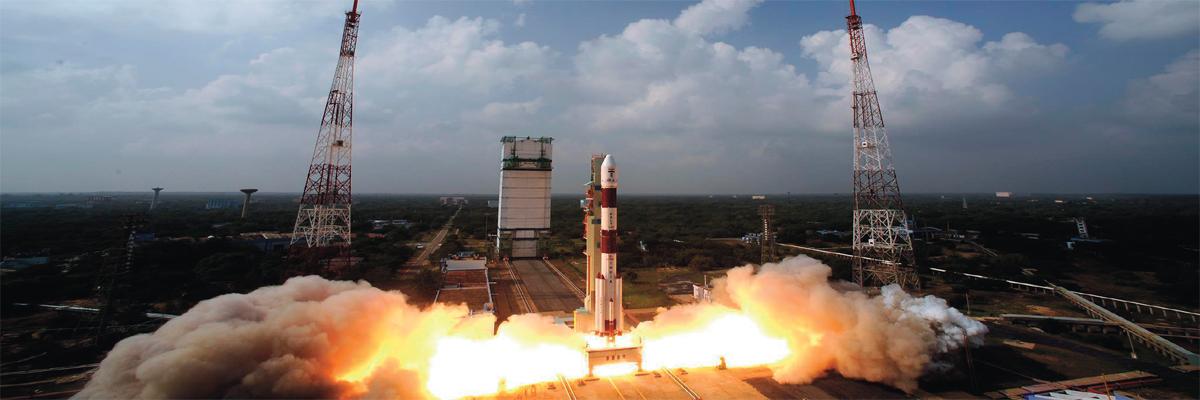Live
- BJP urges EC to stop Cong’s ‘Guarantee Cards’ campaign aimed to 'induce voters'
- Congress cheated Madigas: Dr. RS Praveen Kumar
- CBDT signs record 125 pacts to ease tax payments by big multinational firms
- Kamal Nath accuses BJP of ‘threatening’ Congress leaders in Chhindwara
- Odisha: BJP, BJD allege violation of MCC
- PM Modi lands in Guwahati to kickstart poll campaign
- ‘100 day action plan’ is PM Modi’s signature style for setting goals and meeting targets
- BJP will change the Constitution if they come to power again, says Priyanka Gandhi
- BJP-led NDA to cross 390-mark in Lok Sabha polls, predicts India TV-CNX survey
- Haier launches new TV series in four sizes in India
Just In

Going back in time, Indias first endeavour into the interplanetary space, Mars Orbiter Mission MOM, has been exploring and observing Mars surface features, morphology, mineralogy and the Martian atmosphere
I don't pretend we have all the answers.
But the questions are certainly
worth thinking about - Arthur C Clarke
Indian Space Research Organisation (ISRO) has been very successful in almost all of its space missions. Most recently, the heaviest and most-advanced high throughput communication satellite GSAT-11, developed by ISRO, was successfully launched from the Spaceport in French Guiana at 02:07 am (IST) on December 05, 2018. During the last one month, ISRO has successfully completed three satellite and two launch vehicle missions.
Going back in time, India's first endeavour into the interplanetary space, Mars Orbiter Mission (MOM), has been exploring and observing Mars surface features, morphology, mineralogy and the Martian atmosphere. After completing an interplanetary journey of more than 10 months, covering a distance of 780 million km, the Mars Orbiter Mission — more aptly known as Mangalyaan — has entered orbit around Mars on September 24, 2014, at 8.15 am (IST).
Well, so much has been talked about the accomplishment of space missions. Nonetheless, hardly ever there has been a confab about the visionaries behind the satellite technology.
Let it be the success of Mars Orbiter Mission or the most recent success of the launch of GSAT-11 or for that matter successful launch of any other artificial satellite — there was a visionary behind the entire satellite technology, whose contribution should be disentombed by the entire world. He was none other than Sir Arthur Charles Clarke. He was born on December 16, 1917. Evidently, he was the man far ahead of his era.
In the year 1945, an article about the notion of artificial satellites was published in Wireless World Magazine. The article titled, “Extra Terrestrial Relays: Can Rockets Give Worldwide Radio Coverage?”, written by Arthur C Clarke, an ordinary man who at that time was employed with the British Royal Air Force became the basis of the entire satellite technology.
In his own words: “Every revolutionary idea seems to evoke three stages of the reaction. They may be summed up by the phrases: (1) It is completely impossible. (2) It is possible, but it is not worth doing. (3) I said it was a good idea all along.” Strictly going by his view, most of the people who read the article, in the beginning, horrified the possibility of his idea as purely an imaginary or fictitious one.
Nonetheless, he was the first person, who talked about the geostationary orbit — an imaginary orbit that has an orbital period equal to Earth's rotational period i.e. 23 hours, 56 minutes, 4 seconds. He was also the first one to calculate the distance of geostationary orbit as 35,786 km above the Earth's equator and following the same direction of Earth's rotation.
Amidst so much of criticism, a few visionaries took Clarke’s concept earnestly and started working on it. Bowing to many experiments, the journey of the world’s artificial satellites has begun sixty-one years before, on October 4, 1957. On that date, the Soviet Union had launched the earth’s first artificial satellite Sputnik-I, whose actual name was Sputnik Zelmi. In a string of technological successes, the Soviet launch of the world’s first artificial satellite was one triumph.
The successful and progressive launch of Sputnik has safeguarded the Soviets to become closer in economic and political relations with third world nations across the world. Very soon, both the superpowers — the United States and the Soviet Union — were occupied with the development of new technology, in the course of the 1950s.
From then on, the world never looked back. So many advancements have, soon after, taken place in the satellite systems, making the world almost wireless. The first true communication satellites — Telstar I and Telstar II — were launched in July 1962 and May 1963, respectively. The modern-day mass media applications like satellite television and the Internet have the satellite technology as their basis. Yes, it is the communication satellites that made Satmass Media, a possibility!
Sir Arthur Charles Clarke had a diverse career as a writer, underwater explorer, space promoter and science populariser. Beyond question, Arthur C Clarke’s heirloom bridges the gaps prevalent in the domains of the arts and the sciences. His works vacillated from scientific discovery to science fiction, and from technical applications to entertainment.
Clarke, as an engineer, as a futurist, and as a humanist, has influenced most of the scientists and engineers working in our day. Of course, through his comprehensive range of works, he continues to motivate forthcoming generations around the world. Let this great creative thinker receive the world’s approbation on his birth anniversary on December 16! (The writer is an Air veteran, a mass communicator and author of more than 10 mass media books)

© 2024 Hyderabad Media House Limited/The Hans India. All rights reserved. Powered by hocalwire.com







